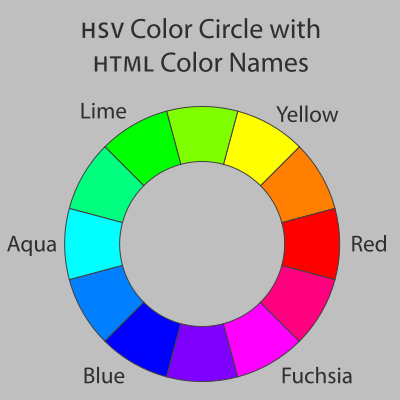Today I want to talk about subtractive color films. Take a deep breath. For those who want the details I am going to get a bit technical. Two good sites, consulted here, where you can find additional information are the Wikipedia site on Kodachrome and an excellent site from the Physics Department at the University of Colorado.
I think that after our discussion of Technicolor you can see the appeal of a film where everything is built in – no registration, no bonding, no fuss. So basically we are talking about a film with three emulsion layers each dyed with one of the primary colors.

Figure 1 – The RYB or HSV color circle showing color complements. From the Wikicommons by Jacoblus under creative commons license.
Let’s begin with something that I haven’t yet shown you, namely a color wheel. So-called color spaces are very complicated. In addition to the mix of the colors you need to worry about hue, saturation, and lightness. If you work with Adobe Photoshop, you will be familiar with this. But let’s leave these issues for another day and consider Figure 1, which shows the simple color wheel that describes the Red, Yellow, Blue color system. The point here is that the complement of yellow is blue, of red is aqua (aka cyan), and of (lime) green is magenta, etc. Each of these colors will remove its complement, when light is passed through or reflected off it. So to get yellow remove blue and vice versa.OK so again, in a subtractive film like Kodachrome we have three layers of emulsion one for each of the primary colors. Each emulsion layer consists of a silver halide with a chemical called a “coupler.” The coupler will undergo a reaction during the development and form a dye wherever there is free silver. Coupler can be added either during manufacture (eg. Ektachrome, where little oil droplets in the emulsion contained the coupler) or during development (eg. Kodachrome). The first is called a substantive film and the latter is called a non-substantive film – because the coupler is or is not a substantive part of the emulsion. Non-substantive films tend to be sharper, or finer grained, because the emulsion is thinner
Needless-to-say development was complicated, and as I’ve said before required very precise temperature control. For Kodachrome this was out of the reach of amateurs. Ektachrome could be developed at home by the brave of heart.
Obviously, there’s a lot more to it and the Devil is in the details. For instance, silver halides are intrinsically blue sensitive. By chemical modification red or yellow sensitivity could be added. However, these red and yellow sensitive layers were still blue sensitive. So to complicate matters the blue layer was placed on top of the stack and it was separated from the other layers with a blue absorbing that is a yellow filter layer. However, the basic concept and fundamental point to remember is that of three separate emulsions each with a coupler that enabled them to be dyed for a particular set of complementary colors.
Kodachrome was introduced in 1935. It served as a very fine and special color movie and still film. There is a film clip circulating on the web and claiming to be a 1922 Kodachrome film test. It is worth watching for its wonderful soft and beautiful color. It was taken by Eastman Kodak as it tried to develop viable color processe. However, the film was taken by an early Kodachrome process similar to the two color Technicolor process and not the commercial Kodachrome process ultimately released.

Pingback: How is the latent image developed, stopped, and fixed? | Hati and Skoll Gallery